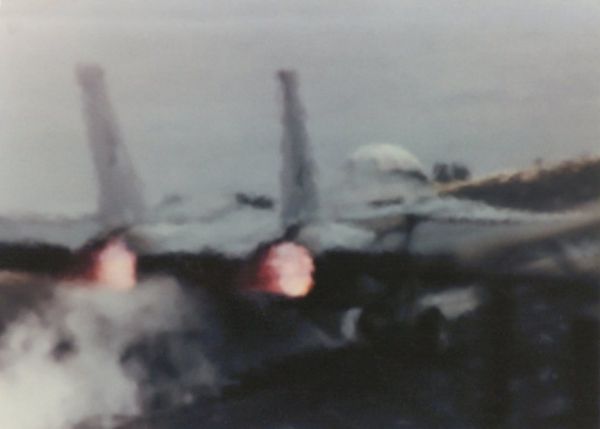
|
F-14's Jet Engines Todays F-14s are powered by two different engines (not two different engines in one F-14, but two types in the F-14 fleet), the old TF30 and the new and more reliable General Electric F110. The new engine has increased power and enables the Tomcat to launch from a catapult without the use of afterburners and even allows to climb away after catapult launch when one engine is lost. The F110 was considered so reliable that it entered service even without clearance for afterburner take-offs! In 1981 an alternative engine was tested in the first F-14B, then the designation for a Grumman prototype (BuNo. 157986) with a pair of Pratt & Whitney F401-PW-400 engines. But after extensive tests with this engine technical difficulties occured and the engine was rejected. Today the F-14's two engine-variants can easily be distinguished comparing the exhaust nozzles. TF30-P-414A: This is the engine that is still operable in the F-14A, an engine that made a lot of trouble and caused some loss of life and aircraft. F110-GE-400:  | ||
| P&W TF30 Engine: | GE F110 Engine: | ||
| Diameter | 1245 mm | 1180 mm | |
| Weight | 1825 kg | 1740 kg | |
| Rate of airflow | 118 kg/s | 120 kg/s | |
| Bypass Ratio | 0.73 | 0.85 | |
| Max. Combustion Chamber Temperature | 1590 K | 1745 K | |
| Thrust | 68.0 kN | 73.8 kN | |
| Thrust with Afterburner | 112.0 kN | 124.5 kN | |
| Specific Fuelconsumption | 68 kg/(kNh) | 75 kg/(kNh) | |
| Specific Fuelconsumption with Afterburner | 255 kg/(kNh) | 201 kg/(kNh) | |
|
Note the specific fuel consumption for both engines with afterburner! If you read the numbers it is obvious why it is so important that the Tomcats (Bs & Ds) can launch from the carrier without the use of the fuel-eating afterburners: An F-14B/D needs some 800 kg of fuel per MINUTE at maximum take-off thrust! F-14 engine nozzle "parking" position: The TF30's afterburner nozzles are regulated open or closed individually by each engine's afterburner fuel control system. The afterburner fuel control pumps are individually operated using the hydraulic pressure produced by the combined and flight hydraulic systems. The port engine powers the combined hydrualic system and the starboard engine powers the flight hydraulic system. Click here to view a graphic showing the Engine Exhaust Noise Level or click here to see a graphic with the F-14's Engine Exhaust Temperature and Wake Velocity Distribution. 




















| |||
Top of the page |
F-14 Tomcat Walk-Around Details:
4-Side View |
Access Panels |
AGM-88 HARM |
AIM-7 Sparrow |
AIM-9 Sidewinder |
AIM-54 Phoenix F-14 Tomcat: Other Topics: Start Page Foreword FAQ Updates Copyright © by Torsten Anft | ||